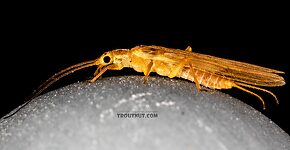Blog & Latest Updates
Fly Fishing Articles
Insects by Common Name


> > Stuck on the family ID on this one -- any thoughts?
The Specimen
Isoperla fusca (Yellow Sally) Stonefly Adult View 13 PicturesThe family ID on this one was a little bit tricky. Just going by the size, shape, and color, it looks like Chloroperlidae. However, the second anal vein of the forewing is does not appear to be forked, and the apical (Apical: Close to the apex; tip or end.) maxillary palpal segment is close to the length of the penultimate segment, both of which rule out that family. The position of the cubitoanal crossvein (Crossvein: Short cross-wise veins in an insect wing which connect the long longitudinal (length-wise) veins.) relative to the anal cell in the forewing -- touching it in this case -- indicates Perlidae (and it really doesn't have the "look" of Perlidae at all), but other characteristics, such as the metathorastic sternacostal sutures and lack of gill remnants, point to Perlodidae. That's the right answer. Moving on to Perlodidae, the key characteristics in Merritt & Cummins lead straightforwarly to Isoperla, and the species key in Jewett 1959 (The Stoneflies of the Pacific Northwest) leads to Isoperla fusca.
View 13 PicturesThe family ID on this one was a little bit tricky. Just going by the size, shape, and color, it looks like Chloroperlidae. However, the second anal vein of the forewing is does not appear to be forked, and the apical (Apical: Close to the apex; tip or end.) maxillary palpal segment is close to the length of the penultimate segment, both of which rule out that family. The position of the cubitoanal crossvein (Crossvein: Short cross-wise veins in an insect wing which connect the long longitudinal (length-wise) veins.) relative to the anal cell in the forewing -- touching it in this case -- indicates Perlidae (and it really doesn't have the "look" of Perlidae at all), but other characteristics, such as the metathorastic sternacostal sutures and lack of gill remnants, point to Perlodidae. That's the right answer. Moving on to Perlodidae, the key characteristics in Merritt & Cummins lead straightforwarly to Isoperla, and the species key in Jewett 1959 (The Stoneflies of the Pacific Northwest) leads to Isoperla fusca.
There is one caveat: That source does suggest a May-July emergence, whereas this one was collected in mid-September.
 View 13 PicturesThe family ID on this one was a little bit tricky. Just going by the size, shape, and color, it looks like Chloroperlidae. However, the second anal vein of the forewing is does not appear to be forked, and the apical (Apical: Close to the apex; tip or end.) maxillary palpal segment is close to the length of the penultimate segment, both of which rule out that family. The position of the cubitoanal crossvein (Crossvein: Short cross-wise veins in an insect wing which connect the long longitudinal (length-wise) veins.) relative to the anal cell in the forewing -- touching it in this case -- indicates Perlidae (and it really doesn't have the "look" of Perlidae at all), but other characteristics, such as the metathorastic sternacostal sutures and lack of gill remnants, point to Perlodidae. That's the right answer. Moving on to Perlodidae, the key characteristics in Merritt & Cummins lead straightforwarly to Isoperla, and the species key in Jewett 1959 (The Stoneflies of the Pacific Northwest) leads to Isoperla fusca.
View 13 PicturesThe family ID on this one was a little bit tricky. Just going by the size, shape, and color, it looks like Chloroperlidae. However, the second anal vein of the forewing is does not appear to be forked, and the apical (Apical: Close to the apex; tip or end.) maxillary palpal segment is close to the length of the penultimate segment, both of which rule out that family. The position of the cubitoanal crossvein (Crossvein: Short cross-wise veins in an insect wing which connect the long longitudinal (length-wise) veins.) relative to the anal cell in the forewing -- touching it in this case -- indicates Perlidae (and it really doesn't have the "look" of Perlidae at all), but other characteristics, such as the metathorastic sternacostal sutures and lack of gill remnants, point to Perlodidae. That's the right answer. Moving on to Perlodidae, the key characteristics in Merritt & Cummins lead straightforwarly to Isoperla, and the species key in Jewett 1959 (The Stoneflies of the Pacific Northwest) leads to Isoperla fusca. There is one caveat: That source does suggest a May-July emergence, whereas this one was collected in mid-September.
Collected September 17, 2020 from the Yakima River in Washington
Added to Troutnut.com by on September 19, 2020
Added to Troutnut.com by on September 19, 2020
The Discussion
| Troutnut | September 19th, 2020, 11:03 am | |
Administrator Bellevue, WAPosts: 2737 | See the caption to this specimen for the reasons why I'm not sure what family to place it in. In a nutshell, it looks like Chloroperlidae, seems to key to Perlidae, and doesn't look like Perlidae at all. I'm either missing or misinterpreting some key features or stumbled upon a specimen that violates a bunch of "usually" characteristics in the key. | |
| Jason Neuswanger, Ph.D. Troutnut and salmonid ecologist | ||
| Troutnut | November 12th, 2020, 11:24 am | |
Administrator Bellevue, WAPosts: 2737 | The new microscope cleared this one up for me; I'm fairly confident it's Isoperla, and most likely fusca, although the timing doesn't match the reported emergence times for that species in a 70-year-old source. | |
| Jason Neuswanger, Ph.D. Troutnut and salmonid ecologist | ||
Quick Reply
You have to be logged in to post on the forum. It's this easy:
Troutnut.com is copyright © 2004-2024 Jason
Neuswanger (email Jason). See my FAQ for information about use of my images.
 privacy policy
privacy policy

